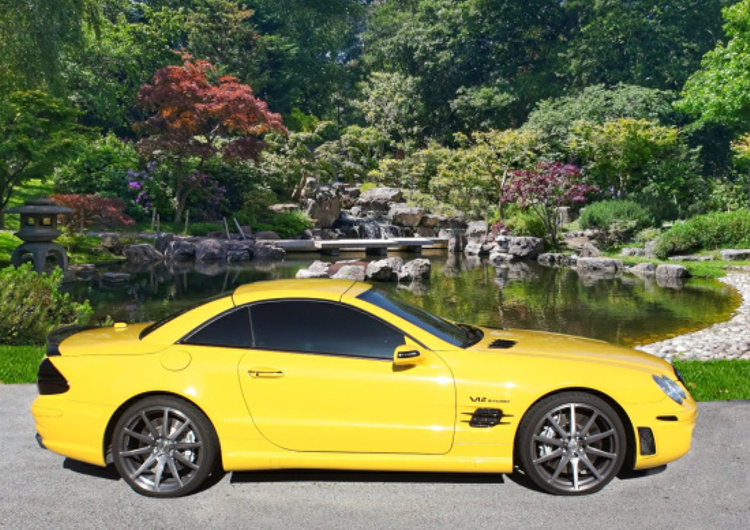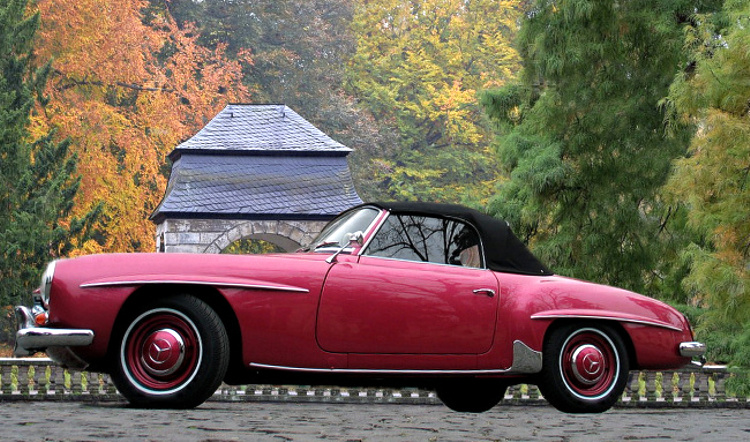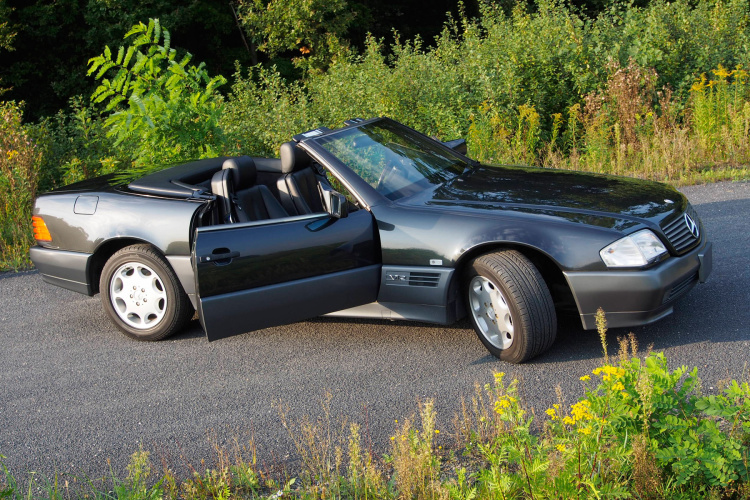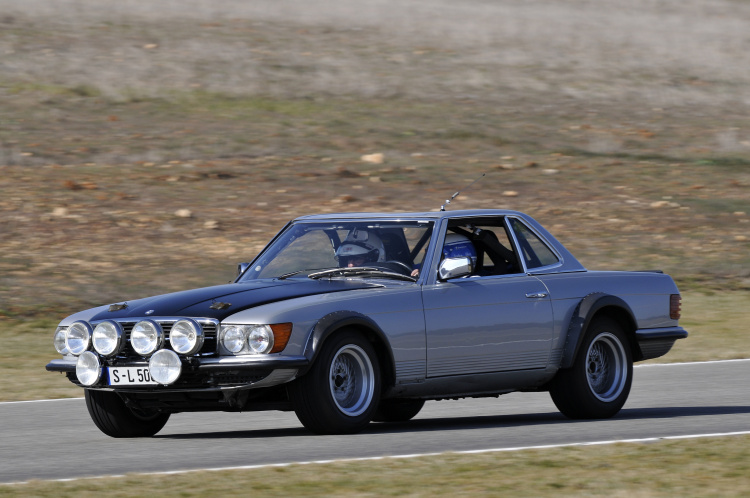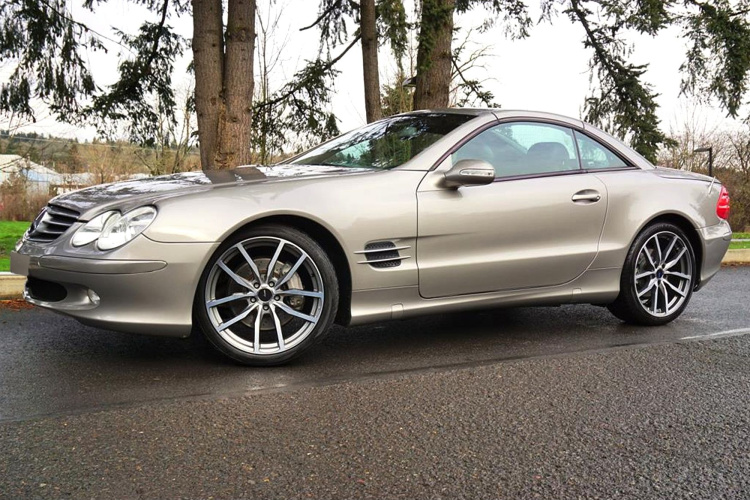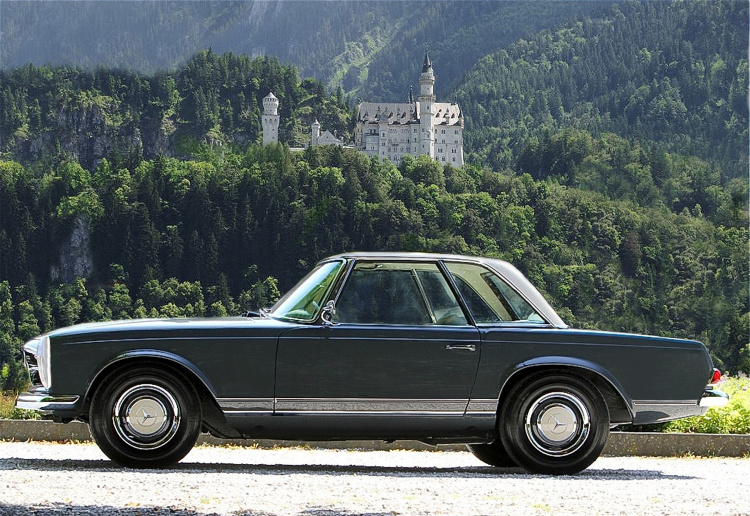Mercedes R 230, the fifth Generation SL
The Mercedes R 230 series SL is the fifth generation of the venerable sports car, if one does not count the 190SL (this is what Daimler-Benz does).
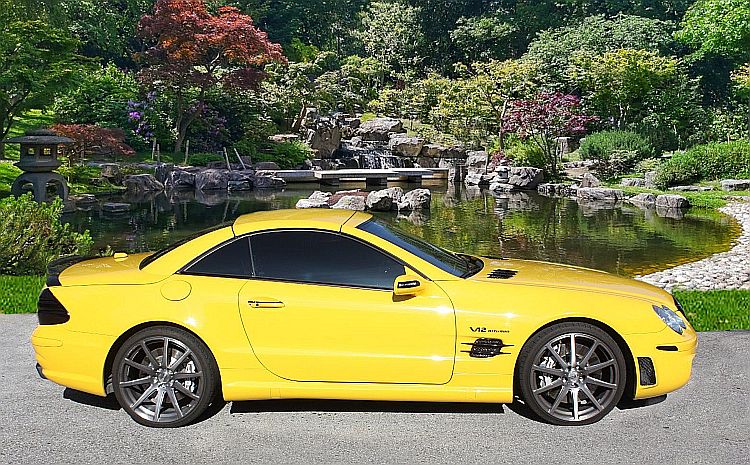
Most of its predecessors had been presented to the automotive world in the month of March at the Geneva International Automobile Show. This time it was different. It happened in July 2001 at the “Deichtorhallen” in Hamburg in Northern Germany. The Deichtorhallen is not just any ordinary congress center, it is one of the largest exhibition centers for modern art in Europe. 500 journalists from around the world had been invited to witness the celebration, where Daimler-Benz presented its new shooting star. Lionel Richie and Juliette, a young German singer, performed the song “The One”, which was composed by Lionel Richie and Leslie Mandoki for this very event.
It was not only the song that was unique. In typical SL tradition, the Mercedes R 230 was unique in many ways too. The most striking feature was its new retractable vario-roof steel hardtop, which was operated by a hydraulic pump and eleven computer-controlled hydraulic cylinders. From now on, the SL carried its hardtop with it, there was no more separate storage for the hardtop needed in the garage. Whether one liked it or not, the soft top was history for some time to come.
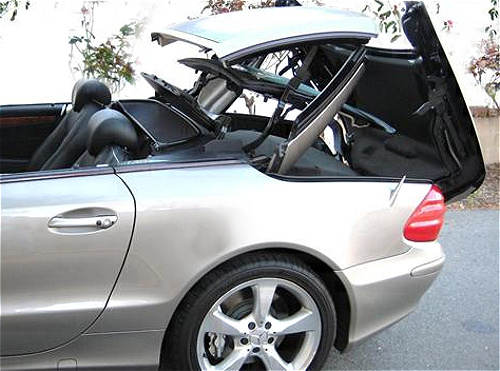
A prototype with such a roof had been shown already in 1994. And the first production Mercedes to be equipped with the vario-top was the SLK, launched in 1996. An unusual option was the Panorama glass roof. It could be ordered as an extra for $1,840.- .
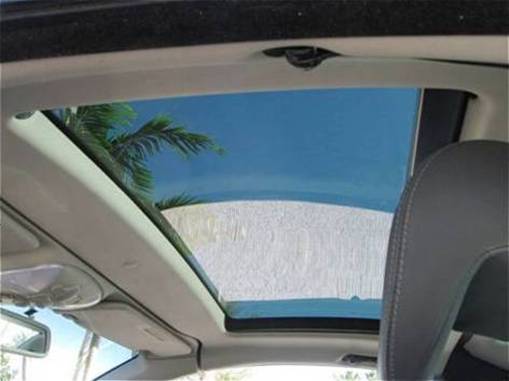
But not only the soft top was history, also the full-sized spare wheel was not available anymore. In order to maximize luggage space, a tiny spare with a compressor to fill it had to play that role now.
Via remote control or at the push of a button inside the car, the roof could be opened or closed within 16 seconds. The 1996 SLK needed 25 seconds for the same procedure. An extremely complex swiveling mechanism ensured that the three roof components disappeared into the upper part of the trunk. Underneath it, 235 liters (8.3 cu ft) of luggage space were available. A small button could be pushed to slightly raise the folded hood again, so a little more luggage space became available. With the top up, that space increased to 317 liters (11.2 cu ft), which was 50 liters (1.8 cu ft) more than the R129 had to offer.
Mercedes R 230 SL with a softer design
The design of the Mercedes R 230 was a careful mixture of tradition and modern styling. Ten young designers from Germany, the US and Japan started in 1996 with first drawings.
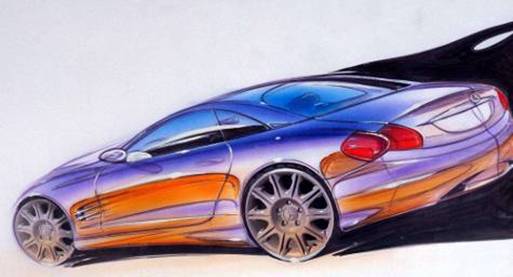
The picture with P. Pfeiffer showed an interesting detail that did not make it into series production: the line that runs along the car’s body on top of the air vents. This line was picked up again in the R231.

Head of design Peter Pfeiffer explaining the design philosophy behind the new Mercedes R 230 SL
Part of the long SL tradition came into play at the front fenders, where the air intakes used a typical feature of the 300SL from the 1950s. The thin, wing-like silver colored segments on these vents were also a reminder of the proud history of the SL brand.
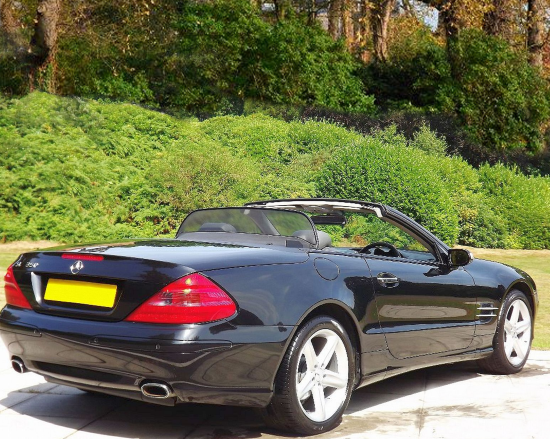
The horizontally elongated radiator grille had always been an unmistakable feature of the SL. This traditional design was somewhat altered, as the new car showed a more modern, flatter slope than its predecessor, the R 129. Helped by the wind tunnel-dictated wedge shape of the body, it made the front appear very dynamic.
The headlamps carried on with a theme, first introduced in the E-Class W210 in 1995: the “four-eyes” design. In the SL they were merged into a single unit without giving up their basic oval shape.
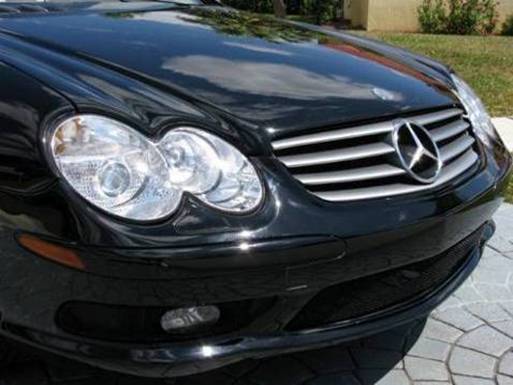
The long hood took up the curves of the headlamps and carried them into muscular looking fenders. Another line developed in the lower part of the fenders underneath the air intakes, ran along the doors and connected with the rear bumper. The steeply raked windshield enhanced the sports car character with its low, wedge-shaped silhouette.
The rear end was characterized by large, triangular-shaped tail lights, similar to the ones of the SLK, which displayed a uniform red. Special filters in front of the reflectors ensured that the turn indicators still appeared yellow and the reversing light white.
In order to improve the new car’s fuel economy, parts such as the hood, front fenders, doors, trunk lid and tank partition were made from aluminum. Still, with all the comfort and safety features added, the car was even with the increased usage of aluminum fairly heavy. Depending on the engine and extras chosen, it could weigh between 1.755 and 2.120 kg (4,065 to 4,565 lbs). Fuel economy of the SL500 was on average in the city 15.7 l/100 km (15 mpg), while it improved to 9.8 l/100 km (24 mpg) on highways.
A drag coefficient value of 0.29 for the closed vehicle spoke for the sophisticated aerodynamics of body and undercarriage. The R 129 had a cd-value of 0.32 with the hardtop attached. The open-top Mercedes R 230 achieved a cd-value of 0.34 with the side windows up, while the R 129 had one of 0.40.
The list of standard equipment got longer
The extensive standard equipment of the SL included leather-upholstered integral seats, which had a less massive looking aluminum frame than the ones in the R 129. The electric seat and steering wheel adjustment was equipped with a memory function, which was additionally stored in the electronic ignition key.
Other standard features were a multifunction steering wheel, automatic climate control and a Bose audio system with CD changer. A long list of options was available to personalize the car, such as the DISTRONIC proximity control system, the COMAND control and display system or an electronic tire pressure monitoring system.
A very popular option was the “Sport Package”. With 18-inch five twin spoke AMG wheels, high performance tires and lower body sculpting, it gave the SL the look (but not the price tag) of the AMG SL55.
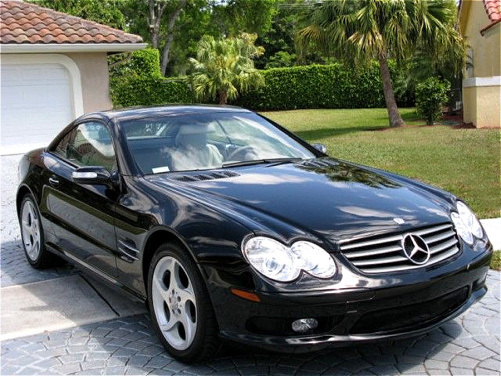
Mercedes R 230 with optional AMG sport package
Next to bi-xenon headlamps, also the KEYLESS GO system was a frequently ordered extra. In the shape of a credit card one could place it anywhere in one’s pockets and entered and drove the car without inserting a key into the ignition. To start the engine, one only had to push a button sitting right on top of the gear shifter.
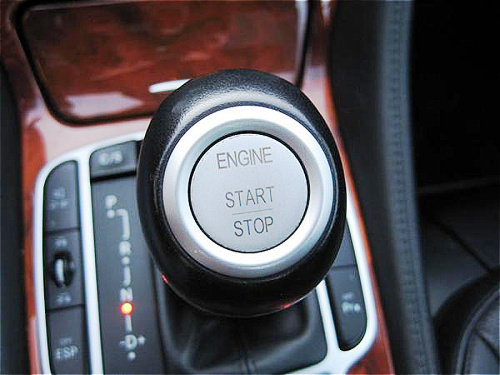
The owner had the choice of two types of leather, four trim variants and five appointment colors. Matt-finished chrome rings framed the four individual, classic chronometer-style dashboard instruments. Wood veneer applications could be ordered in walnut, chestnut or black ash.
Part of the reason why the SL was larger than its predecessor was increased interior space. It was 5 cm (1.97 in) longer and offered 2 cm (0.79 in) more headroom. While the R129 could still be ordered with additional jump seats, the interior of the new SL was now reserved for just the driver and passenger.

Mercedes R 230 SL and its early engine choices
The first model to become available was the SL500 with an output of 305 hp. It was the same three-valve-per-cylinder M113 engine that was already installed in the R129. The alloy engine weighed only 183 kg (403 lbs) and 90% of its total torque of 460 Nm (339 lbs-ft) was already available at 2,000 rpm. It accelerated from 0 to 100 km/h in 6.3 seconds and achieved an electronically regulated top speed of 250 km/h (155 mph). As with the earlier SL, the V8 was only available with a five-speed automatic transmission with electronic control, two shift programs, and torque converter lockup clutch. A newly developed touch shift permitted very fast manual gearchanges. In Sept. 2003 the transmission was changed to a new, and industry-first, seven-speed transmission, called 7G-TRONIC.
The base price of the SL500 was in Germany €94,308. While it cost £67,790 in the UK, it was available in the US at $85.990.-.

The SL55 AMG joins the Mercedes R 230 party
In September 2001 the fantastic SL55 AMG was introduced. It became finally available in the spring of 2002 with a supercharged V8 engine, which was based again on the M113. It developed 476 hp, which was a whopping 122 hp more than the previous R129 SL55 had offered. Its 5.5 l (331.9 cu in) engine delivered unbelievable 700 Nm (516 ft-lbs) at already 2,650 rpm and accelerated from 0 to 100 km/h in just 4.7 seconds. That was even better than the old R129 SL73 V12 AMG. The engine was mated to a strengthened five-speed automatic transmission with steering wheel gearshift paddles.
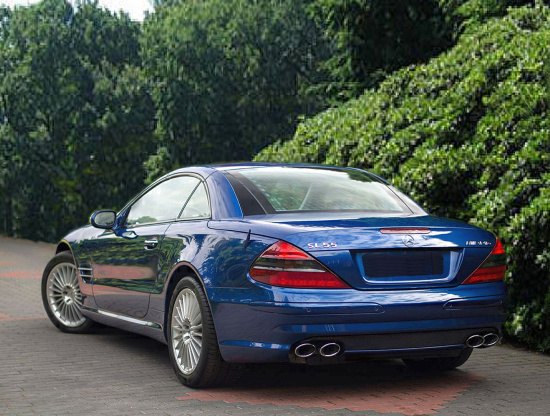
The electronic speed limit of 250 km/h could be removed at a slight surcharge of €1,500, so that the car’s top speed increased to 300 km/h. In that case, a warning was given to the driver to pay special attention to the correct tire pressure. In Germany, most of the SL55 were ordered without the speed limiter. Although the car was an AMG model, it was produced not in Affalterbach near Stuttgart, home of AMG, but in Bremen alongside the other R230s. At €124,236 it was one of the most expensive Mercedes on offer. But it was also as fast as supercars like the Ferrari 360 Spider or Lamborghini Gallardo. Compared to them, the SL55 was a bargain. In the US, the car sold at $117,220.- and in the UK at £89,040.-
First problems appeared
As people quickly found out, the new Mercedes R 230 series was unfortunately not without its faults. The COMAND interface might have been liked by its designers. But just as the first iDrive of BMW, its supposed intuitiveness was not universally appreciated by the car’s drivers. Some saw it even after a few years of ownership with a fair amount of frustration. Some encouraged Daimler-Benz (at that time still Daimler-Chrysler) in letters to look to their Japanese competitors for a remedy. Unfortunately the same could be said about the quality of the car. “Consumer Report” in its April 2004 and 2005 editions saw the expensive SL500 slide to the bottom of the reliability chart. It was best to avoid as a used car. The April 2005 report on the other hand rated the SL among the highest for satisfaction. One possible reason for the difference could be that most Mercedes dealers were by now aware of the quality problems. And they were not unique to the SL. In the early years of the new century they could be observed with other models of the once iconic brand too. It appeared that the dealers tried also in their own interest everything possible to make their customers happy again. Many, but not all problems were remedied with the 2006 facelift. The COMAND interface for example was something, many customers complained about till the end of production of the Mercedes R 230.
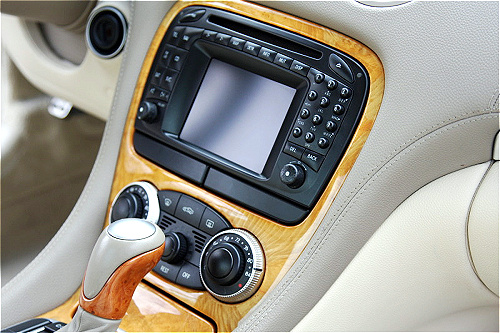
Another major problem was an engineering masterpiece. At the same time, it was a technological overkill, as one car magazine called it. It was offered next to the SL also in the E-class. It was the electro-hydraulic braking system, called SBC for “Sensotronic Brake Control”. It operated in conjunction with the Electronic Stability Program ESP and the Active Body Control ABC. ABC minimized body movements and any tendency to skid when cornering and braking. SBC was called by Mercedes technicians the gateway to the future “by wire” systems. It no longer transmitted driver’s commands mechanically or hydraulically, but electronically – by cable.
Two updates (MOPF) increased the SL’s quality
The Mercedes R 230 received two updates, one in 2006 and one in 2008. The 2006 update included
- new engines for SL350 and SL500/SL550
- new top-of-the-line SL65 AMG
- ABC (Active Body Control) was improved to reduce body movement
- a new 7-speed 7G-Tronic automatic transmission
Exterior styling changes included
- new front bumper with three large cooling air intakes
- fog lamps with chrome surrounds
- new light-alloy wheels
- revised rear lights
The 2008 update included
- new, more aggressive front
- the 3.5 L V6 is uprated to 311 PS
- a new entry-level SL280 develops 231 PS
- the facelifted SL63 AMG loses its 5.4 L M113 in favour of the newer M156 6.2 L V8
Much more about the Mercedes R 230, including special edition models and famous tuners such as Brabus, RENNtech (the car below is an SL600 tuned by RENNtech) or Carlsson, can be read in my book and e-book about the R 230 SL. It also includes a buyer’s guide and explains the VIN and data card. I am sure you will enjoy reading it.
A German version of the book can be found here.

